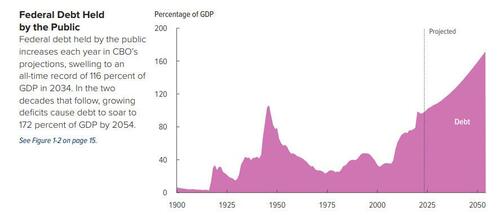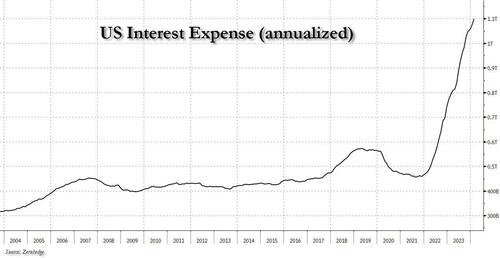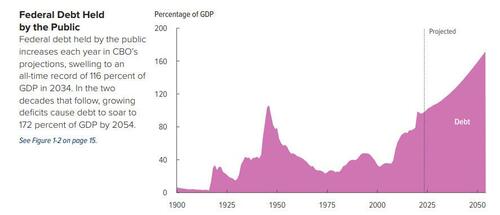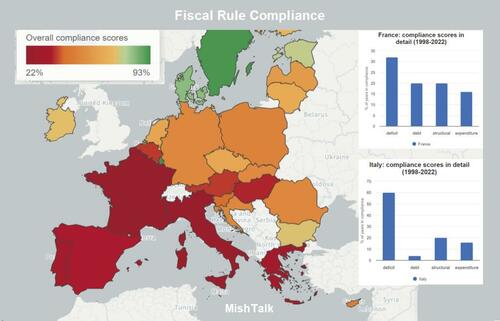In the new normal nothing ever happens. The Central Banks have our back so why worry? "Spending a life worrying for something that may or may not happen is no way of spending a life!" Fine. But as Hemingway said when he went bankrupt: Little by little then suddenly. For the US too, the sun will Set. It will be suddenly and it may not be in a faraway future.
We've
been pointing it out for so long - in fact, for most of our 15 years in
existence - that it has become more of a chore than actual reporting,
especially since the "number only go up",
as it hits a new all time high virtually every day. We are talking, of
course, about the exponential curve that is the US debt, arguably one of
the most boring and at the same time, most exciting topics of all time
(because one day the "number go up no more" and you want to be far, far away when that happens).

Perhaps the catchiest observation we made on the trajectory of US debt was last September when we first noted that it is rising by $1 trillion every three months, or every 100 or so days...
... a soundbite which has since been picked up and stolen by pretty much everyone else in the media, if with the usual 6+ month lag behind us.

Not
only has it gotten boring to be ahead of the curve by almost half a
year, but pretty much every possible warning that could be said about
the exponential increase in the US debt has been - well - said.
And
yet, every now and then we are surprised by the latest developments
surrounding the unsustainable, exponential trajectory of US debt. Like,
for example, the establishment admitting that it is on an unsustainable,
exponential trajectory.
That's precisely what happened overnight when in an interview with the oh so very serious Financial
Times (which has done everything in its power to keep its readers out
of the best performing asset class of all time, bitcoin), the director
of the Congressional Budget Office, Phillip Swagel, issued a stark
warning that the United States could suffer a similar market
crisis as seen in the United Kingdom 18 months ago, during former Prime
Minister Liz Truss’s brief stint leading Britain - which briefly
sent yields soaring, sparked a run on the pound, led to an immediate
restart of QE by the Bank of England and a bailout of various pension
funds, not to mention the almost instant resignation of Truss - citing the nation’s "unprecedented" fiscal trajectory.
The
striking words from the head of the CBO, best known perhaps for
publishing doomer debt/GDP projection charts such as this one...

... warned of the dangers of the U.S. facing “what
the U.K. faced with former prime minister Truss — where policymakers
tried to take an action, and then there’s a market reaction to that
action", comes as US government debt continues to break
records, fueling concerns about the burden that places on the economy
and taking a toll on America’s credit rating.
As a reminder, in
September 2022, Truss roiled markets as she pressed for significant tax
cuts, including changes lessening the tax burden on wealthier
individuals without offsets, as well as other economic measures. The
budget proposal spurred a major selloff of British debt, forcing U.K.
interest rates to decades-long highs and causing the value of the pound
to tank. While Truss defended her agenda as a means to spur economic
growth, she stepped down as prime minister after less than two months on
the job following the market revolt to her administration.
Meanwhile,
it was up to the Bank of England to bail everyone out: the central bank
intervened in the market, pledging to buy gilts on “whatever scale is
necessary” with Dave Ramsden, a senior official at the central bank,
saying at the time that "were dysfunction in this market to continue or worsen, there would be a material risk to UK financial stability.”
Needless
to say, by bringing up the catastrophic rule of Truss, who for at least
a few days tried to impose a regime of fiscal and monetary austerity
which immediately blew up the UK bond market and led to an instant
market crisis, Swagel is admitting that there is nothing that can be
done to reverse the growth of US debt and to make what is already an
exponential chart less exponential. Quite the opposite, in fact.
And
while Swagel said the U.S. is “not there yet,” he raised concerns of
how bond markets could fare as interest rates have climbed.
Specifically, he warned that as higher interest rates raise the cost of
paying its creditors, on track to reach $1 trillion per year in 2026,
bond markets could “snap back."
Well, we have some bad news, because if one calculates total US interest on an actual, annualized basis... we don't have to wait until 2026, we are there already and then some.
Indeed,
it seems like it was just yesterday when everyone was talking about US
debt interest surpassing $1 trillion (and more than all US defense
spending). Well, hold on to your hats, because as of this month, total
US interest is now $1.1 trillion, and rising by $100 billion every 4
months (we should probably trademark this before everyone else steals it
too).

According
to the CBO, US government debt is set to keep rising. “Such large and
growing debt would slow economic growth, push up interest payments to
foreign holders of US debt, and pose significant risks to the fiscal and
economic outlook,” it said in a report last week. “It could also cause
lawmakers to feel more constrained in their policy choices.”
Only that will never happen, because
a politician who is "constrained" in their policy choices - one who
doesn't feed the entitlements beast in hopes of winning votes (while
generously spreading pork for friends and family) - is a politician who
is fired.
Perhaps afraid he would sound too much like ZeroHedge,
the CBO director left a glimmer of hope, saying that the nation has “the
potential for some changes that seem modest — or maybe start off modest
and then get more serious — to have outsized effects on interest rates,
and therefore on the fiscal trajectory.” But we doubt even he believes
it.
In the CBO’s long-term budget outlook report released last
week, the budget agency projected the national deficit would rise
“significantly in relation to gross domestic product (GDP) over the next
30 years, reaching 8.5 percent of GDP in 2054.” Which of course, is
laughable: the US deficit is already at 6.5% of GDP - a level that
traditionally implied there is a major economic crisis - and yet here we
are, with unemployment *reportedly* at just 3.8%. Said otherwise, the
US deficit will - with 100% certainty - hit 8.5% of GDP during the next
recession which will likely be triggered as soon as Trump wins the
November election.

The budget scorekeeper attributed the projected growth to rising interest costs, as well as “large and sustained primary deficits, which exclude net outlays for interest." In
short, everything is already going to hell to keep "Bidenomics" afloat,
but when you also throw in the interest on the debt, well.. that's game
over man.
Socialists, and other liberals who are only good at
spending other people's money and selling debt until the reserve
currency finally breaks, quickly sprung to defense of the debt black
hole that the US economy has become.
Bobby Kogan, senior director
of federal budget policy at the communist-leaning Center for American
Progress think tank, pointed to improved deficit projections in recent
years, as well as forecasts from the CBO he said “don’t project anything
that looks like a panic.”
“If someone were thinking about,
‘Should I panic or should I not panic?’ I would just say, ‘hey, the
underlying situation has gotten better, right?’” Kogan said, adding
“there’s been lower, long-term projected deficits in the Biden
administration.”
Instead of responding, we will again just show the latest CBO debt forecast chart and leave it up to readers to decide if they should panic or not.

What Kogan said next, however, was chilling: “You
either should have been worried a long time ago, or you should be less
worried now,” he said. “Because we’ve been on roughly the same path for
forever, but to the extent that it’s different, it’s better.”
Actually
no, it's not better. It much, much worse, and the fact that supposedly
"serious people" are idiots and make such statements is stunning
because, well, these are the people in charge!
But he is certainly right that "you should have been worried a long time ago" - we
were very worried, and everyone laughed at us, so we decided - you know
what, it's not worth the effort, may as well sit back and watch it all
sink.
And now bitcoin is at a record $72,000 on its way to $1
million and gold is at a record $2,200 also on its way to... pick some
nice round number.... in fact the number doesn't matter if it is
denominated in US dollars because very soon, the greenback will go the
way of the reichsmark.
And just to make sure that nothing will
ever change, even after the US enters the infamous Minsky Moment,
shortly after the close we got this headline::
- *UNITED STATES AA+ RATING AFFIRMED BY S&P; OUTLOOK STABLE
Because when nobody dares to tell the truth, why should anything change?













